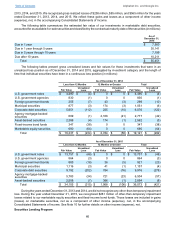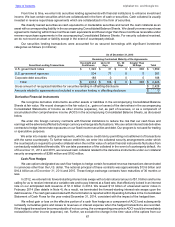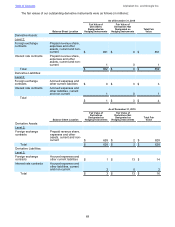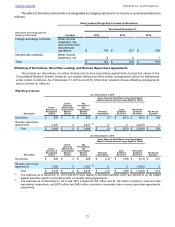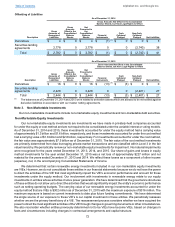Google 2015 Annual Report Download - page 67
Download and view the complete annual report
Please find page 67 of the 2015 Google annual report below. You can navigate through the pages in the report by either clicking on the pages listed below, or by using the keyword search tool below to find specific information within the annual report.
Table of Contents Alphabet Inc. and Google Inc.
63
recoverable. We measure recoverability of these assets by comparing the carrying amounts to the future undiscounted
cash flows that the assets or the asset group are expected to generate. If the assets are considered to be impaired,
the impairment to be recognized equals the amount by which the carrying value of the asset exceeds its fair market
value. In 2014, we recorded impairments of intangible assets, including an impairment of $378 million in the third
quarter of 2014 related to a patent licensing royalty asset. Impairments of intangible assets were not material in 2015.
We allocate goodwill to reporting units based on the reporting unit expected to benefit from the business
combination. We evaluate our reporting units when changes in our operating structure occur, and if necessary, reassign
goodwill using a relative fair value allocation approach. We test our goodwill for impairment at least annually, or more
frequently if events or changes in circumstances indicate that the asset may be impaired. No goodwill impairment has
been identified in any of the years presented.
Intangible assets with definite lives are amortized over their estimated useful lives. We amortize our acquired
intangible assets on a straight-line basis with definite lives over periods ranging from one to twelve years.
Income Taxes
We account for income taxes using the asset and liability method, under which we recognize the amount of taxes
payable or refundable for the current year and deferred tax assets and liabilities for the future tax consequences of
events that have been recognized in our financial statements or tax returns. We measure current and deferred tax
assets and liabilities based on provisions of enacted tax law. We evaluate the realization of our deferred tax assets
based on all available evidence and establish a valuation allowance to reduce deferred tax assets when it is more-
likely-than-not that they will not be realized.
We recognize the financial statement effects of a tax position when it is more-likely-than not that, based on
technical merits, the position will be sustained upon examination. The tax benefits of the position recognized in the
financial statements are then measured based on the largest amount of benefit that is greater than 50% likely to be
realized upon settlement with a taxing authority. In addition, we recognize interest and penalties related to unrecognized
tax benefits as a component of the income tax provision.
Foreign Currency
Generally, the functional currency of our international subsidiaries is the local currency. We translate the financial
statements of these subsidiaries to U.S. dollars using month-end exchange rates for assets and liabilities, and average
rates for the annual period derived from month-end exchange rates for revenues, costs, and expenses. We record
translation gains and losses in accumulated other comprehensive income as a component of stockholders’ equity. We
reflect net foreign exchange transaction gains and losses resulting from the conversion of the transaction currency to
functional currency as a component of foreign currency exchange losses in other income (expense), net.
Advertising and Promotional Expenses
We expense advertising and promotional costs in the period in which they are incurred. For the years ended
December 31, 2013, 2014 and 2015, advertising and promotional expenses totaled approximately $2,389 million,
$3,004 million, and $3,186 million.
Recent Accounting Pronouncements
In May 2014, the Financial Accounting Standards Board (FASB) issued Accounting Standards Update No. 2014-09
(ASU 2014-09) "Revenue from Contracts with Customers." ASU 2014-09 supersedes the revenue recognition
requirements in “Revenue Recognition (Topic 605)”, and requires entities to recognize revenue when it transfers
promised goods or services to customers in an amount that reflects the consideration to which the entity expects to
be entitled to in exchange for those goods or services. As currently issued and amended, ASU 2014-09 is effective
for annual reporting periods beginning after December 15, 2017, including interim periods within that reporting period,
though early adoption is permitted for annual reporting periods beginning after December 15, 2016. We are currently
in the process of evaluating the impact of the adoption of ASU 2014-09 on our consolidated financial statements,
implementing accounting system changes related to the adoption, and considering additional disclosure requirements.
In June 2014, the FASB issued Accounting Standards Update No. 2014-10 (ASU 2014-10) "Development Stage
Entities (Topic 915): Elimination of Certain Financial Reporting Requirements, Including an Amendment to Variable
Interest Entities Guidance in Topic 810, Consolidation." ASU 2014-10 removes the definition of a development stage
entity from the Master Glossary of the Accounting Standards Codification (ASC) thereby removing the financial reporting
distinction between development stage entities and other reporting entities. The additional elimination of related
consolidation guidance will require companies with interests in development stage entities to reassess whether such
entities are variable interest entities under ASC Topic 810, Consolidation. We will adopt this standard in the first quarter















